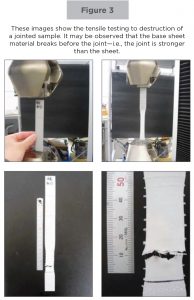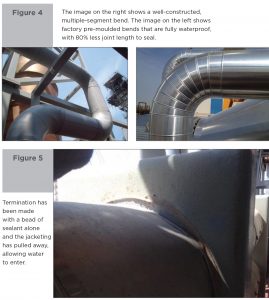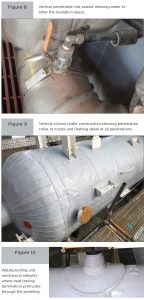Corrosion under Insulation Prevention—Removing the Electrolyte
Corrosion under insulation (CUI) remains one of the greatest costs related to maintaining assets in the oil, gas, and petrochemical industries, but why is it so widespread?
John Williams of Aspen Aerogels and Norman Rennalls of Shell Global Solutions used
the “Bow Tie” model for risk assessment in their 2019 paper, “A Different Framework for Understanding and Managing CUI.” Figure 1 illustrates this model.
Rennalls and Williams proposed changing the focal point from CUI being the “Hazardous Event” to “Moisture in the Insulation Space” (see Figure 2); but why?
What Is CUI, and How Can it Be Stopped?
Many in the insulation industry recommend preventing moisture intrusion at the start through design and installation, as a CUI management practice. Corrosion occurs due to the formation of a corrosion cell. In order to prevent corrosion, the cell must be broken by removing a component. Without all four components, corrosion cannot happen.
The four components of a corrosion cell are:
- Anode,
- Cathode,
- Electrolyte, and
- Return Path.
Remove any one of the above, and corrosion is prevented. It becomes more complicated however, because the anode, cathode, and return pathway can all be present in the metal substrate by itself, leaving only the electrolyte: water. Therefore, if water can be removed from the equation, the formation of a corrosion cell and CUI can be prevented.
Why Is CUI so Widespread?
Many jacketing systems are designed to watershed, rather than to be waterproof, and sometimes systems get damaged, which allows moisture in. Wet insulation can lead to CUI. The management of CUI is then dependent upon recovery measures, such as coatings and intensive inspection regimes. Rather than expecting moisture and recovery, Rennalls and
Williams argue for proper design based on three “control measures” that can prevent moisture in the insulation space and, therefore, prevent CUI: jacketing, hydrophobic insulation, and drainage.
Preventing Moisture from Entering the Insulation Space
No water = no CUI, but is that possible?
Unless jacketing sheet/material is physically damaged, water does not pass through it, whether it is aluminium, stainless steel, PVC, glass fabricated, mastic, flexible chlorosulfonated polyethylene elastomer (CSPE) jacketing, or UV-curing glass-reinforced plastic. Water enters at joints, penetrations, and terminations. For a jacketing system to be fully watertight, it must have design details for these risk areas providing mechanical and waterproofing integrity, with longevity.
Joints
An effective system design is one where the joint between sheets and components is stronger than the base sheet material itself and does not penetrate the waterproofing layer with screws and rivets. Figure 3 shows an example of the joint material being stronger than the the sheet. A flexible system can, by its very nature, accommodate expansion and contraction. In circumstances of extreme expansion and contraction, the system includes a fully waterproof expansion joint.
The jointing method uses both adhesive and sealant. The role of the adhesive is to provide mechanical integrity that is able to accommodate implied loads, such as foot traffic, without damage. The role of the sealant is to provide waterproofing integrity. The combination of the two delivers a waterproof joint that has mechanical robustness
and will withstand abuse.
The application of pre-moulded fittings has the advantage of substantially reducing the number and length of joints required, speeding up application time and helping the applicator by making it easier to achieve waterproofing integrity (see Figure 4).
Terminations
Where jacketing ends, it is commonplace to find that there is no sealant at all; or the integrity of the termination relies on a bead of sealant alone, without proper mechanical integrity (see Figure 5).
Effective terminations require there to be a mechanical fix, including a bonded joint or adhesives, between the jacketing and the pipe, bulkhead, support ring, etc. In this way, the jacketing will not become separated at the termination, and no load is applied to the sealant, whose only job is to provide waterproofing integrity (see Figures 6 and 7).
Penetrations
Vertical penetrations are quite possibly the greatest risk for water entering the insulation space. If sealed at all, often the sealant is at risk of pulling away as a result of foot traffic or similar damage (see Figure 8).
The use of pre-moulded penetration collars that are bonded and sealed both to the penetrating piece and the jacketing provides a long-term solution to waterproofing; and flashing detail applied around irregular penetrations such as steelwork supports and brackets delivers the same CUI prevention benefit (see Figure 9).
Certain materials, such as those used in the manufacture of termination boxes for trace heating cables, do not adhere well to adhesives and sealants, in which case self-amalgamating silicone tape may be used in conjunction with pre-moulded penetration collars to provide a fully waterproof seal (see Figures 10 and 11).
Application Quality
Regardless of the level of detail in the design of a jacketing system, its effectiveness at preventing water from entering the insulation space is only as good as the quality of the application.
Many manufacturers offer assistance and some have a quality assurance process that includes training and assisting applicators to achive best-practice standards.
Drain Holes
Rennalls and Williams identify “drainage” as a key control measure to prevent water in the insulation space. This is an obvious point in cases where the jacketing system is not designed to be waterproof, but why would drains be included in a fully sealed and waterproof system? The answer is that in the event the jacketing is opened to perform maintenance, and then not properly reinstalled, water may enter the insulation space. In a fully sealed system, water would continue to accumulate and fill the system. Drains at every low point and every 10’ on pipe runs prevent such an accumulation until the source of water ingress is repaired.
Conclusion
Corrosion continues to be a costly problem for the industrial market. Resources are available to help plant managers select insulation materials, design systems, and minimize corrosion. Jacketing systems are available that fully seal so water cannot enter the insulation space, preventing CUI in accordance with the “Bow Tie” risk analysis model described by Williams and Rennalls.







